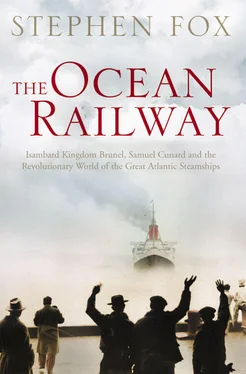Not quite; Cunard had skipped the thorny guesswork, which had so undone Junius Smith and Macgregor Laird, of predicting how soon his vessels would be built and available. To strengthen his case with the government, Cunard needed signed contracts for constructing his ships and engines. Still very much on his own, he appraised the feuding centres of British marine engineering. Because the Great Western company was already operating out of Bristol, and Smith and Laird out of London and Liverpool, Cunard’s search naturally drifted north to Glasgow. James C. Melvill, secretary to the East India Company, recommended the Glaswegians Robert Napier and John Wood, who had recently built the swift steamship Berenice for his company’s trade with India. In late February, two weeks after his successful proposal to the Admiralty, Cunard asked an intermediary in Glasgow to see what Napier and Wood would charge for one or two steamships of 800 tons and 300 horsepower, to be built and ready for sea in only twelve months. ‘ I shall wantthese vessels to be of the very best description,’ he emphasized, ‘and to pass a thorough inspection and examination of the Admiralty. I want a plain and comfortable boat, but not the least unnecessary expense for show. I prefer plain work in the cabin, and it saves a large amount in the cost.’ Napier was at once quite interested, so Cunard went up to Glasgow to see him.
It is no hyperbole to say that their meeting in early March 1839 set the course of the Cunard Line for at least its first quarter-century. Napier had just finished his enormous engine for the British Queen, after embarrassing delays and relentless criticism from engineers on the Thames. He therefore welcomed another shot at building an Atlantic steamship engine. Cunard, still so unknown to most British commercial circles, needed Napier’s technical expertise and his reputation along the Clyde for shrewd business dealings. The two men were about the same age – Napier was four years younger – and of similar personalities: terse, contained, not given to public displays or extravagant statements, immersed in work, and sheltered by their families to unusual degrees. Each could recognize and (mostly) trust the other. Napier even brought Cunard home to meet his wife and children. Entrepreneur and engineer, the two formed a variation on those symbiotic partnerships that had driven the Industrial Revolution: a kind of Boulton and Watt for ocean steamships.
In Glasgow, Napier took Cunard to see his famous Vulcan Foundryand its redoubtable works manager, David Elder. The foundry sprawled across a large quadrangle on Washington Street, near the river. A sign at the gate advised, ‘No admittance except on business’, and the din and pace of work inside showed that Napier and Elder meant it. Operations were broken down into four specialized areas. In the casting house, furnaces melted raw metal to be poured into sand moulds in a pit. Some of the castings were quite large, up to a twenty-four-ton bedplate for a marine engine. This sector was relatively quiet, unlike the open area where boilers and funnels were pounded together. The steady, arhythmic jangling of hammers on rivets, iron meeting iron, pealed forth the raggedy music of the Industrial Age. It took 10,000 rivets to make an average boiler, each driven home by repeated metallic blows, all day long. The smithery joined the heat of the casting house to the hammered cacophony of the boilermakers: sweaty, muscular blacksmiths toiling over their anvils and forge fires, turning rough metal into finer pieces, with a small steam engine puffing away to force air into the forge fires. The engineering shops, the largest department, held various specialized lathes and boring and planing machines, all driven by steam-powered beltings overhead, to shape and finish to exact tolerances the cylinders, pistons, wheels, and smaller parts of a steam engine. Seven hundred men worked long days at the Vulcan, six days a week. When the noise stopped at closing time, the silence itself was deafening. Sam Cunard could only have been impressed.
As Napier and Cunard got down to the details, the size of the ships kept increasing, a process that would continue through months of revised contracts. They at first agreed on three ships, 200 feet long and 960 tons, of 375 horsepower, to cost £32,000 each. (A ship this size was still only half the tonnage of the British Queen.) Napier would build the engines, and his shipbuilding associate John Wood would provide the vessels, all by the spring of 1840. ‘ He appearsfrom the little I have seen of him to be a straight-forward business man,’ Napier noted of Cunard. ‘ From the frankoff-hand manner in which he contracted with me, I have given him the vessels cheap, and I am certain they will be good and very strong ships.’
Cunard returned to London, brought his first Napier contract over to the Admiralty and Treasury, and found them ‘highly pleased’. Reporting this news to Napier, Cunard invoked the regional engineering rivalries, then raging, to warn and inspire Napier to his best efforts and punctuality. ‘You have no ideaof the prejudice of some of our English Builders,’ Cunard wrote, guileless in his guile. ‘I have had several offers from Liverpool and this place and when I have replied that I have contracted in Scotland they invariably say “You will neither have substantial work or completed in time.” The Admiralty agree with me in opinion the Boats will be as good as if built in this Country and I have assured them that you will keep to time.’ (An oblique reference to the British Queen and her delays.) Someone else had told him that Thames engines would use less coal per horsepower, but Cunard assured the man he was mistaken and pointedly reported the exchange to Napier: ‘The Admiralty cautioned me on this head therefore take good care that you bear me out in my assertions. ’ Cunard also pressed Napier and Wood to start building his ships (‘How is Mr Wood progressing – tell him I will be down upon him some of these mornings when he may not expect me’).
‘ I am sorrythat some of the British tradesmen should indulge in speaking ill of their competitors in Scotland,’ replied Napier, not surprised. ‘I shall not say more than court comparison of my work with any other in the kingdom.’ The two men, so new to each other, were still forming crucial first impressions by poking around and testing the other, gradually settling into what became the most important working relationship of their lives. Cunard sent along reports of the latest patented steam innovations; Napier, playing his expected engineering role, passed sceptical judgments and reassured the entrepreneur. ‘ I was quite preparedfor your being beset with all the schemers of every description in the country,’ he advised Cunard. ‘Every solid and known improvement that I am made acquainted with shall be adopted by me, but no patent plans.’
For his part, Cunard was having serious money problems. He still had no signed contract with the government. The first Napier deal was just with Cunard: he alone had to come up with a binder of £5000 and the first instalment of £5000 more. At the same time, precisely the wrong time, his falling out with George Renny Young forced him to find about £14,000 to completehis purchase of the Young family’s interest in the Prince Edward Island land company. Juggling the two enterprises, Cunard was caught without enough cash in England. When Napier took his first note from Cunard to the bank, it was accepted only after a suspicious delay and objections. Napier was surprised and dismayed. ‘ The truth is,’ Napier warned Cunard, ‘had I not been completely satisfied beforehand from other trustworthy sources of your undoubted respectability and highly honourable character, my confidence in you would have been shaken.’
Читать дальше












